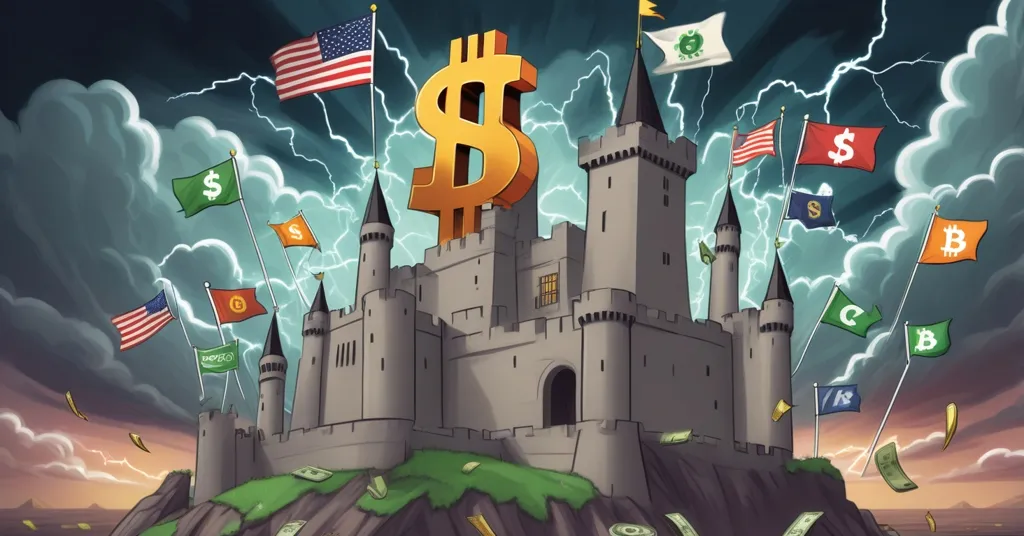Tether’s $20 Billion Raise: Stablecoin Dominance or Dangerous Overreach?

Tether’s $20 Billion Gambit: Stablecoin Wars and Financial Frontiers
Tether, the powerhouse behind the world’s leading stablecoin USDT, is reportedly on the verge of raising a staggering $15-20 billion through a private placement, a move that could peg its valuation at an eye-watering $500 billion. As the stablecoin market turns into a global battlefield and nations push for financial independence, Tether’s ambition is both a beacon of crypto’s potential and a lightning rod for scrutiny.
- Colossal Fundraising: Tether eyes $15-20 billion raise, potentially valuing the company at $500 billion.
- Operational Mess: Mining arm in Uruguay hit with $4.8 million debt and power cutoff, mulling an exit.
- Stablecoin Showdown: US dollar tokens dominate, but non-dollar alternatives signal a revolt against financial hegemony.
Tether’s $20 Billion Gamble: Ambition or Overreach?
The word from Tether’s camp, with Wall Street firm Cantor Fitzgerald in the advisory seat, is that this massive cash infusion isn’t just about padding the books. CEO Paolo Ardoino has made it clear they’re playing a bigger game.
“[We’re] evaluating a raise from a selected group of high-profile key investors, to maximize the scale of the Company’s strategy across all existing and new business lines (stablecoins, distribution ubiquity, AI, commodity trading, energy, communications, media) by several orders of magnitude,”
Ardoino’s vision paints Tether as a sprawling empire, branching into AI, energy production, and even media. With USDT already boasting a $172.7 billion market cap and Tether reportedly raking in multi-billion dollar quarterly profits, you’d think they’d have enough to fund their own moonshot. So why the raise? Is this about genuine expansion or a desperate bid to shore up credibility amid lingering questions about their reserves—echoes of the 2021 New York Attorney General settlement where they paid $18.5 million for misleading claims about USDT backing? A $500 billion valuation sounds like a crypto fever dream, especially for a company with a history of transparency hiccups. Let’s not kid ourselves: this isn’t just about growth; it’s a power play in a sector where trust is as volatile as a meme coin.
Operational Stumbles: Uruguay’s Power Cut Reality Check
While Tether dreams big, its boots-on-the-ground operations tell a grittier story. In Uruguay, its mining subsidiary Microfin has been caught with its pants down, failing to pay electricity bills since May and racking up a $4.8 million debt to the state utility UTE. The result? Power cut off faster than a rug pull in a shady NFT drop. Sources hint Tether might ditch Uruguay entirely, blaming sky-high energy costs. This isn’t just a minor oops; it’s a glaring chink in their armor that no PR spin can polish. Ardoino has bragged about a $2 billion investment in energy and Bitcoin mining, aiming to make Tether the world’s biggest miner by year-end. For the uninitiated, Bitcoin mining is the energy-guzzling process of using high-powered rigs to validate transactions on the Bitcoin blockchain—a process as thirsty for electricity as a desert wanderer for water. When you can’t keep the lights on, that world-domination talk starts sounding like hot air. Can a $20 billion war chest fix such fundamental flops, or is this a sign Tether’s bitten off more than it can chew?
The Stablecoin Battlefield: Dollar Dominance Under Siege
Zooming out to the broader stablecoin arena, the US dollar still wears the crown. Tether’s USDT leads with its monstrous market cap, followed by Circle’s USDC at $74.2 billion, PayPal’s PYUSD at roughly $1.4 billion, and Ripple Labs’ RLUSD at about $740 million. For those new to the game, stablecoins are cryptocurrencies pegged to stable assets like fiat currency, designed to avoid the rollercoaster swings of Bitcoin or Ethereum. They’re the boring but practical cousins in the crypto family, often used for trading, payments, or parking funds without cashing out to a bank. But don’t let the word “stable” fool you—the competition here is anything but calm.
PayPal is muscling PYUSD onto new blockchain networks through LayerZero, a tech that acts like a universal translator, letting assets zip between different blockchains without a hitch. Ripple’s RLUSD is playing the partnership game, linking up with BlackRock’s tokenized fund BUIDL and Van Eck’s VBILL via Securitize. Think of a tokenized fund as a traditional investment—like a money market fund—turned into digital tokens on a blockchain for speedier, clearer transactions. Securitize CEO Carlos Domingo called this “delivering real-time settlement and programmable liquidity,” which basically means money or assets that move automatically based on coded rules. Meanwhile, USDC is spreading to HyperLiquid, a decentralized futures exchange, but faces heat from a new kid, USDH. Even French banking giant Société Générale is jumping in with USDCV, though the European Central Bank is sweating over the dollar’s grip threatening EU fiscal control. It’s a dogfight, and every player’s scrambling for a piece of the pie.
Non-Dollar Rebellion: A Push for Financial Sovereignty
Here’s where the stakes get geopolitical. Not everyone’s thrilled with the dollar’s chokehold on stablecoins, and countries are striking back with tokens pegged to their own currencies. Kazakhstan rolled out KTZE, tied to the Tenge, with National Bank CEO Timur Suleimenov championing it as a tool to keep liquidity local and boost the domestic digital asset scene.
KTZE “promotes the localization of liquidity within the country, integration with the existing financial infrastructure, and the development of the domestic digital asset ecosystem,”
China’s in the mix with AxCNH, an offshore yuan stablecoin via Hong Kong’s AnchorX, targeting Belt & Road Initiative partners and dovetailing with its digital yuan push. South Korea’s BDACS launched KRW1, pegged to the won, as another middle finger to dollar dominance. This isn’t just tech innovation; it’s a quiet revolt against US financial hegemony, and reports suggest that Tether might be eyeing billions in funding as the appeal of non-dollar stablecoins continues to grow. For nations wary of sanctions or economic leverage, reducing reliance on the greenback is a survival tactic. But let’s play devil’s advocate: can these local stablecoins really compete with the liquidity and trust of USDT or USDC, or are they just symbolic gestures in a dollar-driven world?
Regulatory Minefield and Corporate Appetite
Why are stablecoins blowing up, beyond the hype? They’re a godsend for cross-border payments, slashing fees and delays compared to the dinosaur-paced banking system. A recent EY-Parthenon survey shows 13% of corporations and financial institutions already use them, with 54% of non-users planning to hop on within a year. Over 40% of corporate users report cutting costs by more than 10% compared to fiat. No wonder USDC (77%) and USDT (59%) are corporate favorites. But there’s a massive roadblock: 73% of respondents cited regulatory uncertainty as their top worry, alongside operational clunkiness and spotty banking support.
In the US, the recent signing of the GENIUS Act by President Trump aims to bring some clarity to stablecoin rules, potentially easing corporate jitters. Meanwhile, the EU’s MiCA framework is setting stricter standards, which could either legitimize stablecoins or strangle innovation, depending on how heavy-handed it gets. Globally, the lack of consensus keeps everyone on edge. Will regulation pave the way for mass adoption, or will it just be another bureaucratic mess that stifles crypto’s raw edge? And let’s not forget: centralized stablecoins like USDT often dance to the tune of regulators, which clashes with the decentralization ethos we champion. It’s a tightrope walk, and the fall could be ugly.
Bitcoin Maximalism vs. Stablecoin Reality
As a Bitcoin maximalist at heart, I’ve got to admit stablecoins make me twitch. Bitcoin is the OG of decentralization, a middle finger to centralized control and fiat nonsense. Stablecoins? Many are run by suits, backed by murky reserves, and cozy with regulators—hardly the cypherpunk dream. But let’s be real: BTC’s volatility makes it a no-go for corporate treasuries or instant payments. Imagine a freelancer in Manila getting paid in Bitcoin for a gig, only to watch 10% of their fee vanish in a market dip overnight. Stablecoins fill that gap, offering a steady bridge for real-world use. Cross-border remittances, 24/7 trading liquidity, programmable money—they’re practical tools Bitcoin can’t replicate yet. Still, their centralization risks and regulatory baggage are red flags. Are we trading one master (banks) for another (Tether execs)? It’s a necessary evil, but an evil nonetheless.
The Road Ahead: A Multi-Polar Financial Order?
Tether’s potential mega-raise could either turbocharge its empire or expose it as a house of cards if operational disasters like Uruguay keep piling up. The stablecoin space is a pressure cooker—dollar-based tokens slug it out for supremacy while non-dollar alternatives hint at a fracturing financial monoculture. Corporate interest is soaring, but regulatory quicksand looms large. For all the promise of a decentralized future, the reality is messy, fraught with power plays and trust issues. Is this the dawn of a multi-polar financial order where Bitcoin, stablecoins, and local digital currencies carve out their own turf, or just another crypto bubble waiting to burst? One thing’s for damn sure: the drama’s only getting started, and the stakes for the future of money couldn’t be higher.
Key Takeaways and Burning Questions
- What’s fueling Tether’s $15-20 billion fundraising push?
Tether aims to expand beyond stablecoins into AI, energy, and media, betting big on a diversified empire despite massive profits already in hand. - Why are nations like Kazakhstan and China launching non-dollar stablecoins?
They’re chasing financial sovereignty, localizing liquidity, and cutting reliance on the US dollar as a geopolitical and economic shield. - How fierce is the US dollar stablecoin market competition?
It’s ruthless—USDT dominates, but USDC, PYUSD, RLUSD, and USDCV are gaining ground with aggressive blockchain integrations and partnerships. - What’s blocking broader stablecoin adoption among corporations?
Regulatory uncertainty leads at 73%, alongside operational hurdles and limited banking support, as highlighted by the EY-Parthenon survey. - Why do stablecoins shine for cross-border payments?
They cut costs by over 10% for many users, speed up transfers, and provide constant liquidity, leaving traditional fiat systems in the dust.



